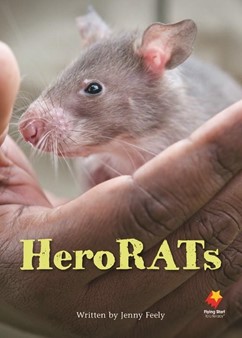Lesson overview
This guided reading lesson will require students to read a non-fiction text. The text provides opportunities for:
- paraphrasing
- summarising the text
- answering evaluative questions.
It is assumed that whole class learning of these strategies will complement the focused learning in small group guided reading.
Text

HeroRats, Author Jenny Feely, Program Flying Start to Literacy
Published by Eleanor Curtain Publishing Pty Ltd
© EC Licensing Pty Ltd. Reproduced by permission.
Text overview
This non-fiction text is about African giant-pouched rats who are trained to smell and identify TNT explosives in landmines or tuberculosis in lung fluid samples. Surprisingly, rats are much more efficient than humans at both jobs. The rats are trained and cared for by their handlers. After the rats finish their working life they are retired where they are looked after comfortably until they die.
Victorian Curriculum – English
Level 4
- Read different types of texts for specific purposes by combining phonic, semantic, contextual and grammatical knowledge using text processing strategies, including monitoring meaning, skimming, scanning and reviewing (VCELY287)
- Use comprehension strategies to build literal and inferred meaning to expand content knowledge, integrating and linking ideas and analysing and evaluating texts (VCELY288)
Learning intention
We are learning to paraphrase to help us understand what we have read.
Success criteria
- I can think about what I have read and put it into my own words.
- I can use my own words to tell someone else about what I have read.
Extension idea
Extend the success criteria (outcome):
- I understand why it is important to think about what I have read and put it into my own words when telling someone else about what I have read.
Lesson sequence
- Hand out individual copies of the text HeroRATs by Jenny Feely (Flying Start to Literacy, Eleanor Curtain Publishing, 2018). Give students a nutshell statement about the text (see Text Overview above).
- Introduce the learning intention. We are learning to put what we have read and understood into our own words. This is called paraphrasing. Paraphrasing is a strategy that helps us to understand what we read. I am going to show you how to do this by using an example from page 18 of the text we are reading today.
Read the first sentence: "Today, HeroRATs are working in countries in Africa and Asia". I am going to put that into my own words. HeroRats work in Africa and Asia.
I am going to keep reading. "Each morning, before it is too hot, the handler takes the HeroRAT to the area that needs to be cleared of landmines. The rat works for 20 minutes, sniffing all over the area." I am going to put that in my own words. 'The HeroRat works for 20 minutes at a time sniffing for landmines in areas where landmines are likely to be found'.
Continue reading. "When a rat finds a mine, it digs into the dirt and the handler places a flag to mark the spot". Ask students to select the key words or phrases in this sentence. How can they use this information to paraphrase? Encourage more than one student to paraphrase this sentence into their own words. Remind students that they can return to the page several times to check they have included the detail. - Introduce the success criteria. As you read the Introduction and Chapter 1 today I want you to stop at the end of each page and go back and try and paraphrase what you have read. You might start by paraphrasing each sentence and then move on to paraphrasing a paragraph. Do this quietly to yourself. Afterwards you will have an opportunity to paraphrase part of the text to the other group members.
- Students read the text quietly to themselves. During this time the teacher hears each child in the group read individually. The teacher selects prompts to scaffold each student based on the learning intention.
What key words and ideas are the most important in this sentence? How might you say it in your own words?
Can you go back and reread this paragraph? What is it telling you? How do you know? Can you say it in your own words?
- After reading, check for understanding.
- Return to the introduction on pages 4 and 5. Ask individual students to volunteer reading a paragraph and then paraphrasing in their own words. What key words, phrases or ideas were important? Support as appropriate.
- Return to the success criteria. Check which students felt confident about putting what they read into their own words. Additionally, check which group members felt confident paraphrasing what they had read for someone else. Record student responses for future learning opportunities.
Extension ideas
High-ability students:
- could be grouped together for the group work component of this task.
- who have already demonstrated the ability to paraphrase could be asked to focus on paraphrasing larger sections of text (paragraphs, pages, etc.).
- could be asked to paraphrase more complex text.
- could be asked to consider why paraphrasing is a useful skill. The teacher may need to guide this discussion.
- could be asked to consider the consequences of not paraphrasing when they are writing about someone else's work (the teacher may need to guide this discussion).
- could be asked to compare and contrast paraphrasing and direct quotation. They can decide when one is more suitable than the other.
- could be asked to apply their knowledge of paraphrasing and direct quotation by using them both in their writing samples.